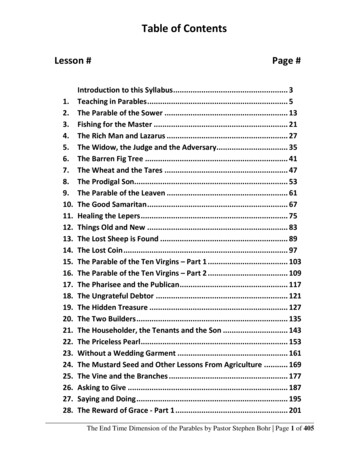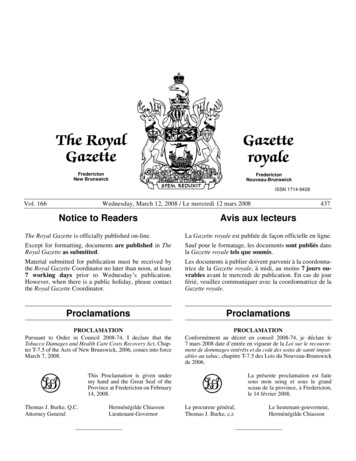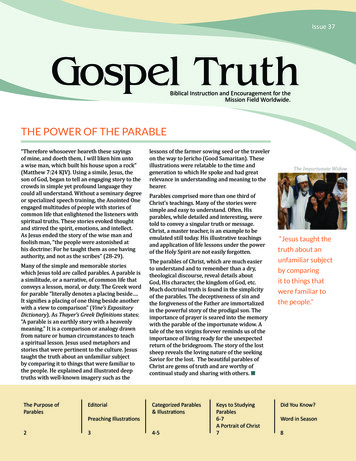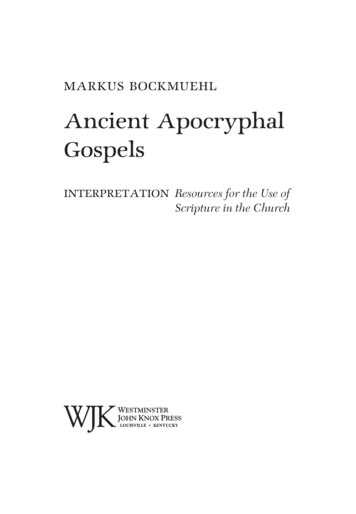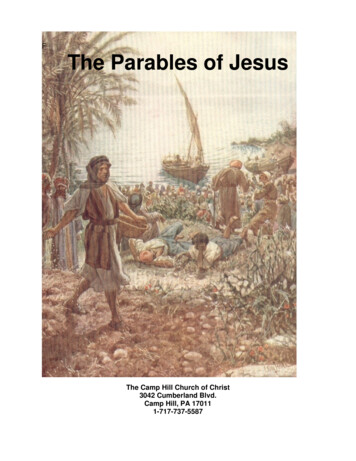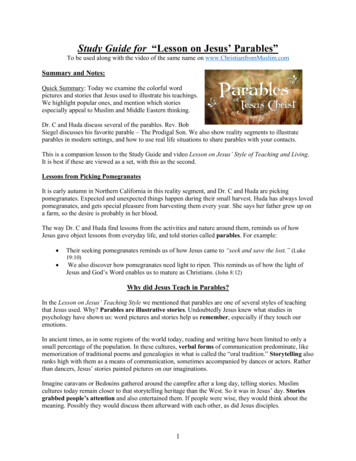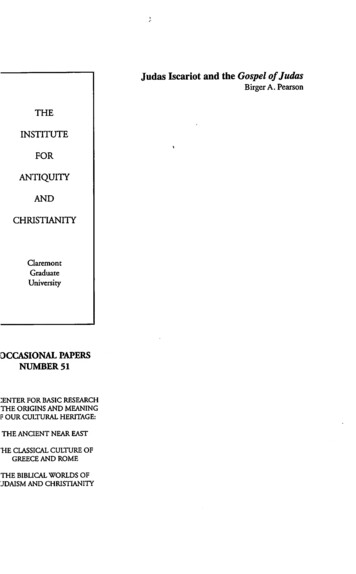
Transcription
The Parablesof Our LordVolume 2By Louis Rushmore
2003, 2008, 2009Louis lgazette.comPictures from Bible View Clip Art 3.0copyright 1996 by Pastoral Computer ServicesUsed by permissionAdditional pictures from assorted clip-art.Cover Art By:Betty Burton ChoatePublished By:J.C. Choate PublicationsP.O. Box 72Winona, MS 38967(662) 283-1192www.worldevangelism.org2
Table of ContentsFOREWORD . 4PUBLISHER’S STATEMENT . 5CHAPTER 1: THE UNMERCIFUL SERVANT. 6CHAPTER 2: THE GOOD SAMARITAN . 15CHAPTER 3: THE RICH FOOL . 26CHAPTER 4: THE BARREN FIG TREE . 35CHAPTER 5: THE GREAT SUPPER . 44CHAPTER 6: THE LOST SHEEP . 53CHAPTER 7: THE LOST COIN . 64CHAPTER 8: THE PRODIGAL SON . 69CHAPTER 9: THE UNJUST STEWARD . 78CHAPTER 10: THE RICH MAN AND LAZARUS . 88CHAPTER 11: THE UNJUST JUDGE . 99CHAPTER 12: THE PHARISEE AND THE PUBLICAN . 107CHAPTER 13: THE TWO SONS . 115BIBLIOGRAPHY . 123GOD’S REDEMPTIVE PLAN . 1243
ForewordThe parables of Jesus have always had a special place in the hearts of serious Biblestudents. One of the great works on our Lord’s parables is the old, but yet invaluable,volume by Richard C. Trench, Notes On The Parables Of Our Lord. It, as this secondvolume, The Parables of Our Lord, is worthy of our study.While the literature on the parables is voluminous, occurring in an unending numberof books, pamphlets and articles, this volume is written for Bible class study. The volumecontains thirteen chapters studying a parable per chapter. They are studies andexpositions that are practical. Each study includes a good introduction followed by athorough discussion on the parable’s background, context and lesson. At the close ofeach chapter there is a series of discussion questions and a section of questions requiringthe student to complete the blanks. Many of the studies contain a crossword puzzlerelating to that parable. Extensive endnotes complete the study and give the more seriousstudent information for additional study.It is said that about one-third of the teaching of Jesus as recorded in the Gospels is inparabolic form. The disciples asked Jesus: “Why speakest thou unto them in parables”(Matthew 13:10). Jesus replied that the parabolic method was used to reveal truth tosome and to conceal truth from others (Matthew 13:11-17).The parables of Jesus set forth in rich terms eternal and heavenly truths by means ofsimple everyday lessons that appeal to all who read and study them. They summarizewhat Jesus thought, taught and how He expected man to live in His kingdom and toprepare for the eternal kingdom, heaven itself.We appreciate the opportunity to write this Foreword. We give our recommendationto this great work. W. Terry Varner4
Publisher’s StatementLouis and Bonnie Rushmore are God’s special answer to our prayers. When J.C.’scancer recurred in 2005, and his health continued to deteriorate with the passing months,we recognized anew our total dependence on God to supply the people who were neededto carry on the work that had been developing since 1960. Beginning as missionaries inKarachi, Pakistan in 1962, our overseas involvement had fostered the printing of booksas follow-up tools for radio and TV programs. Many of the books were printed in India,Sri Lanka, Singapore and the Philippines, but because of the need for literature in otherplaces J.C. began printing materials in the States as well. That has grown to be a servicefor WBS, jail ministries, local evangelism and foreign evangelism, in addition tobecoming the publisher of the accounts of the lives and work of missionaries in manyparts of the world.Good things – eternal things – were being done through these efforts, and we didn’twant them to end with J.C.’s death. In the fall of 2007, God brought the LouisRushmores to be a part of our World Evangelism team in Winona. With Louis’background in preaching, teaching for ten years in a school of preaching, writing andpublishing books and editing his online magazine, Gospel Gazette Online, he and Bonniewere ideal for the work that needed to be done. We continue to be thankful for theirdecision to move to Winona and to join hands with us to share the printed word withpeople who are hungry for the message.Louis brought with him a small printer and a number of books that he had writtenand printed in the past. Parables, Volumes 1 and 2 are two of those books. We arehappy to make them available for use in this format, and we look forward to enablingmany souls to learn the depths of our Lord’s teachings more perfectly through thesepublications. To that end, we commend this volume to you.Betty (Mrs. J.C.) ChoateWinona, MS 38967February 6, 20095
Chapter 1: The Unmerciful Servant(Matthew 18:21-35)INTRODUCTIONPrefatory events to our Lord’s parable of the Unmerciful Servant include: (1) rivalryamong the apostles for prominence “in the kingdom of heaven” (Matt. 18:1), (2) JesusChrist’s illustration of “a little child” to teach humility (Matt. 18:2-5), (3) Christ’sinstruction to avoid offenses (Matt. 18:6-14), (4) Jesus’ teaching how to resolveinterpersonal problems among the children of God (Matt. 18:15-17), (5) the essentially ofunity among the apostles (Matt. 18:18-20), and (6) Peter’s question about forgiveness(Matt. 18:21-22).The Gospel of Mark records that on the way to Capernaum our Lord’s disciplesargued “among themselves who should be the greatest” (Mark 9:33-37). Luke’s accountverifies that this discord occurred (Luke 9:46-48). On a later occasion, James and John,with their mother, sought Jesus to grant them preeminence among the apostles. This selfserving maneuver produced animosity in the other ten apostles toward James and John(Matt. 20:20-28).Strife and offenses resulted from these petty rivalries. The apostles were offended orhad hard feelings toward each other. Jesus countered this potentially disastrous unrestamong his apostles with two lessons: (1) humility to offset the insipid jealousies , and (2)repentance and forgiveness to repair their fellowship with each other and with theGodhead.Satisfactory resolution of foreboding breaches following this incident was critical tothe overall training of the apostles. During his ministry, Jesus prepared them for theexecution of the Great Commission and guidance of the infant church, beginning in ActsTwo. Failure at this juncture would have severely undermined God’s plan to establish thekingdom of prophecy. Similarly, unchecked rivalries or jealousies and ill-will amongmembers greatly hamper any congregation in which those sins are present.Jesus picked up a child as a living illustration of humility (Mark 9:36).“And Jesus called a little child unto him, and set him in the midst of them,And said, Verily I say unto you, Except ye be converted, and become aslittle children, ye shall not enter into the kingdom of heaven. Whosoevertherefore shall humble himself as this little child, the same is greatest inthe kingdom of heaven” (Matt. 18:2-4).Jesus then taught that sinful offenses would occur, despite best efforts to avoid them(Matt. 18:6-14).These trespasses or sins were to be resolved privately and discreetly, if possible.“Moreover if thy brother shall trespass against thee, go and tell him his fault betweenthee and him alone: if he shall hear thee, thou hast gained thy brother” (Matt. 18:15). If
Chapter One: The Unmerciful Servantunable to resolve sinful differences this way, with as little escalation as possible,additional persons ought to lend themselves to terminating alienation among brethren.“But if he will not hear thee, then take with thee one or two more, that in the mouth oftwo or three witnesses every word may be established” (Matt. 18:16). Finally, priorattempts failing to disarm estrangement between brethren, the local congregation isobliged to intervene to restore civility and fellowship. “And if he shall neglect to hearthem, tell it unto the church: but if he neglect to hear the church, let him be unto thee as aheathen man and a publican” (Matt. 18:17).The very office of responsibility for which Jesus prepared his apostles was endangeredby their disaffection for each other. Ordinarily, we turn to Matthew 18:18-20 as evidence ofapostolic authority. Division was counterproductive to their mission as apostles and theauthority with which they were to exercise themselves as apostles (Matt. 18:20).Peter, though accommodating by then contemporary custom, could not envision beingobligated to forgive repeat offenders, irrespective of the number of times one might sinsagainst him. “Then came Peter to him, and said, Lord, how oft shall my brother sin againstme, and I forgive him? till seven times?” (Matt. 18:21). One commentator observes:This was being generous. Rabbis advised forgiving a brother only three times.1With the apostle Peter, it was three strikes and you’re out! Of course,. . . Peter . . . assumed that his brother would sin against him, not he againsthis brother. . . . He wanted to be able to measure forgiveness. This meant hewas thinking of setting a limit: “This far and no further!” The Lord exposedthat fallacy when He said, “Not seven times, but seventy times seven!” Bythe time you have forgiven somebody that many times, you are in the habitof forgiving and will not need to obey rules on set limits.2Peter wanted mercy for himself but exacted justice without mercy on others.3 “Peterindeed was willing to forgive, but his mistake was that he measured himself by a humanrather than a divine standard.”4“Forgiveness must never be refused when sought with repentance.”5 Unfortunately,often brethren superficially purport to forgive while demonstrating by their actions theirreluctance to proffer forgiveness on their fellows. Only rarely have I observed a Christianbrazenly and openly refuse to forgive professed penitents.Repentance must precede forgiveness, though a Christian should always be willingto forgive penitent offenders.“Take heed to yourselves: If thy brother trespass against thee, rebuke him;and if he repent, forgive him. And if he trespass against thee seven timesin a day, and seven times in a day turn again to thee, saying, I repent; thoushalt forgive him” (Luke 17:3-4).To refuse forgiveness to a fellow Christian professing repentance would require theomniscience of God.7
Chapter One: The Unmerciful ServantThe pages of inspiration amply attest to the child of God to be ready always toforgive. “Blessed are the merciful: for they shall obtain mercy” (Matt. 5:7).“For if ye forgive men their trespasses, your heavenly Father will alsoforgive you: But if ye forgive not men their trespasses, neither will yourFather forgive your trespasses” (Matt. 6:14-15).“For with what judgment ye judge, ye shall be judged: and with what measure ye mete, itshall be measured to you again” (Matt. 7:2). “Judge not, and ye shall not be judged:condemn not, and ye shall not be condemned: forgive, and ye shall be forgiven” (Luke6:37). “And forgive us our sins; for we also forgive every one that is indebted to us. Andlead us not into temptation; but deliver us from evil” (Luke 11:4). “And be ye kind one toanother, tenderhearted, forgiving one another, even as God for Christ’s sake hathforgiven you” (Eph. 4:32). “Forbearing one another, and forgiving one another, if anyman have a quarrel against any: even as Christ forgave you, so also do ye” (Col. 3:13).Whereas Peter was willing to forgive someone seven times, Jesus posed a muchlarger number, 70 times seven or 490 times (Matt. 18:22). Jesus used this formulafiguratively to teach that one should always be willing to forgive. The word “Therefore,”with which the parable of the Unmerciful Servant begins, makes a direct relationshipbetween that parable and the foregoing verses that we just surveyed.THE PARABLE“Then came Peter to him, and said, Lord,how oft shall my brother sin against me,and I forgive him? till seven times? Jesussaith unto him, I say not unto thee, Untilseven times: but, Until seventy timesseven. Therefore is the kingdom of heavenlikened unto a certain king, which wouldtake account of his servants. And when hehad begun to reckon, one was brought untohim, which owed him ten thousand talents.But forasmuch as he had not to pay, hislord commanded him to be sold, and his wife, and children, and all that hehad, and payment to be made. The servant therefore fell down, andworshipped him, saying, Lord, have patience with me, and I will pay theeall. Then the lord of that servant was moved with compassion, and loosedhim, and forgave him the debt. But the same servant went out, and foundone of his fellowservants, which owed him an hundred pence: and he laidhands on him, and took him by the throat, saying, Pay me that thou owest.And his fellowservant fell down at his feet, and besought him, saying,Have patience with me, and I will pay thee all. And he would not: butwent and cast him into prison, till he should pay the debt. So when his8
Chapter One: The Unmerciful Servantfellowservants saw what was done, they were very sorry, and came andtold unto their lord all that was done. Then his lord, after that he hadcalled him, said unto him, O thou wicked servant, I forgave thee all thatdebt, because thou desiredst me: Shouldest not thou also have hadcompassion on thy fellowservant, even as I had pity on thee? And his lordwas wroth, and delivered him to the tormentors, till he should pay all thatwas due unto him. So likewise shall my heavenly Father do also unto you,if ye from your hearts forgive not every one his brother their trespasses”(Matt. 18:21-35).According to the commentator, R.C. Trench, the Unmerciful Servant is the firstparable where God is represented as being a king.6 (The parable derives its name fromobservation of the conduct by the first servant. The king called him the “wickedservant.”) Another writer says of the parable, “This is the only parable in the Bible thatdemonstrates the magnitude of God’s forgiveness.”7 Herbert Lockyer writes that theparable of the Unmerciful Servant allows us to ‘glimpse the mercy and compassion of thedivine heart.’8From verse 23, we note that this is another kingdom parable. God is represented hereas a king. The accounting or evaluation, according to Wayne Jackson, is the Gospel call.9The servants represent sinners. Besides the initial examination by the Gospel throughwhich one goes when first acquainted with it, there will also be a final examination. “Sothen every one of us shall give account of himself to God” (Rom. 14:12). The Word ofChrist will be the means by which examination is made then, too (John 12:48). Happily,no one has to fail the final examination that precedes the assignment of an eternal abode.Anyone can take a pre-test and thereafter make any needed adjustments. “Examineyourselves, whether ye be in the faith; prove your own selves. Know ye not your ownselves, how that Jesus Christ is in you, except ye be reprobates?” (2 Cor. 13:5).In verse 24, a servant owed the king an enormous debt, which in this parablerepresents sin. Several factors obscure precisely the equivalent amount to contemporarytimes that this servant owed. First, our economy is highly inflated over first-centuryeconomics in Palestine. Second, the value of a talent varied depending on whether theRoman or Jewish talent is considered. Third, a talent of gold varied greatly in value froma talent of silver. Modern estimates tally the 10,000 talents ranging from about 3,000,000 to 150,000,000.10 In any event, the money owed was an insurmountable debtthat was beyond the servant’s ability to make restitution.Two commentators attempt to provide a frame of reference regarding the enormity ofthis debt with the following illustrations.To understand the buying power of a talent, consider that one talent wouldpurchase a slave. The total annual tax bill for Palestine was about 800talents, and this man owed 10,000 talents! One talent would be equal to 20year’s wages for the average man.119
Chapter One: The Unmerciful ServantIf the Jewish silver talent is under consideration, the servant’s debt was an estimated 10,000,000. References to both gold and silver talents were common throughout Jewishhistory (Exod. 28:24; 1 Kings 10:10; 1 Chron. 29:4-7).In Palestine a laboring man’s daily wages were one shilling(approximately 17 cents). It would have taken 200,000 years to pay offthat debt! This illustrates man’s complete inability to pay off his sin-debtto Jehovah. Man stands bankrupt before God.12The servant’s debt was far beyond his ability to repay. Both Roman and Jewish lawallowed that a debtor could be sold for his debts. For instance, a thief who when caughtwas unable to make restitution was sold (Exod. 22:3). Debts extended to the family of thedebtor, for which family members could be sold (2 Kings 4:1).“Because of our sins, we are under an un-payable debt to God.”13 Selling the servantand his family represents alienation from God because of sin.The servant prostrated himself before the king and pleaded for mercy. Further, theservant anxiously pledged to the king that he would repay the astronomical debts overtime. “A man in such terror and anguish will promise impossible things.”14 “Theservant’s promise to pay all reveals of the vastness of the debt owed . . .”15The servant evidently persuaded the king with much heartfelt emotion.Consequently, the king released the servant from his debt. The liquidation of the debt waswholly due to the compassion of the king in response to an impassioned plea. Justicedemanded repayment. Mercy, though, here was the annulment of the debt. “‘Moved withcompassion’ is a strong expression suggesting being inwardly pained at suffering with adesire to relieve.”16 Our heavenly Father is moved with this same compassion for allmankind (2 Pet. 3:9).Verses 28 and 29 describe a similar event following the servant’s release from hisoppressive debt. This time, though, this first servant required a fellow servant to pay hisdebt to him immediately. He sought and obtained mercy for himself, but he demandedjustice without mercy of his peer. This parable, then, pertains to man’s forgiveness of hisfellow man.The two sums of money owed in the parable are deliberate extremes. Theservant owed his fellow servant a hundred denarii. The denarius was aRoman coin worth about twenty cents, which made this total debt abouttwenty dollars.17The second servant owed about four months’ wages.18 The Greek and Roman customregarding delinquent debtors was to take the debtor by the throat to court for trial.19 “Theworst offenses committed against men are nothing compared to the offenses all havecommitted against God.”20 Therefore, we ought to forgive one another because God hasforgiven us.However, the first servant was deaf to the identical pleas for mercy he himself madeearlier. Instead he cast his fellow servant into prison.10
Chapter One: The Unmerciful ServantThe reason for imprisonment and cruel treatment was to force the debtorto sell what ever property he might secretly own, or to have the debtor’srelatives pay his debt. The creditor would demand slave-labor of thedebtor’s family so that the debt might be worked off.21Verse 31 depicts the sense of wrong noted by still other servants regarding theunmerciful servant. “An unforgiving disposition arouses indignation in others.”22Consequently, the misdeeds of the unmerciful were reported to the king. Appalled at theingratitude, the king reversed his passions toward the unmerciful servant. The“tormentors” to whom the wicked servant was delivered represent eternal hell. Theparable here teaches “God will punish those who are unforgiving.”23 Earlier the parablerepresented the compassion of God. The severity of God is evident also from the parable.Some commentators imagine they have found in this passage biblical evidence forthe Roman Catholic doctrine of “purgatory.” It is to the phrase “till he should pay all thatwas due unto him” in verse 34 appeal is made.The Romish theologians find an argument for purgatory in the words, tillhe should pay all that was due, as also in Matt. v. 26. But it seemsplainly a proverbial expression; for since man could never acquit theslightest portion of the debt which he owes to God, the putting of such acondition was the strongest possible way of expressing the eternalduration of this punishment.24Similar emphasis is used in the crude and picturesque expression, “when hell freezesover” or “when pigs fly.”CONCLUSIONThe moral of the parable is plainly expressed in verse 35. “So likewise shall myheavenly Father do also unto you, if ye from your hearts forgive not every one his brothertheir trespasses” (Matt. 18:35). The forgiveness by God of which children of God arerecipients must be demonstrated by them toward their fellows.The immensity of the debt does not hinder God’s full and free pardon (Isa.1:18; 55:7). God will save the chief of sinners (1 Tim. 1:15). No one isbeyond forgiveness; it makes little difference as to how many, how big,and how long one’s sins have reached.25God, then, teaches us how to forgive. Finally,. . . this parable is striking and impressive because of its acute contrasts.First, there is the contrast of Peter’s number and the Lord’s. Peter waswilling to forgive several times, but the Lord said to forgive to infinity.Second, there is the contrast of the two debts. One was a trifling sum, theother was unpayable.2611
Chapter One: The Unmerciful ServantDISCUSSION QUESTIONS1. Describe, from the perspective of the apostles, the kingdom in which through theirrivalries they sought prominence.2. Explain the impact that dissension among brothers and sisters in Christ has oninterpersonal fellowship and fellowship with God.3. Describe the potentially adverse affect of disharmony of the apostles on the unfoldingplan of God for the establishment of the kingdom (church).4. Describe the condition of a congregation in which rivalries and jealousy continueunchecked.5. Fully explain the procedure given by Jesus for the resolution of interpersonalproblems among Christians. To what type of circumstances does this procedureapply, and to what type of circumstances does this procedure not apply?6. Contrast situations in which it is biblically impossible to extend forgiveness with theChristian obligation to practice forgiveness.7. List sins for which Christians usually have difficulty actually extending forgivenessdespite penitence of the sinner and in spite of our professed willingness to forgive.8. Why do you suppose that the parable of the Unmerciful Servant and instructionimmediately preceding the parable are so lengthy compared to other topics aboutwhich Jesus taught?9. How do you suppose that the unmerciful servant amassed such an enormous debt?10. How can we avoid a final examination for which we are unprepared and eternallydisappointed?11. Explain the affect of one’s sins on other souls, especially his family.12. Describe the contrasting attributes of compassion and severity as they apply to God.13. Contrast the principles of justice and mercy. How can a just God also be merciful?14. Contrast the sins committed against us with the sins committed against God.15. Contrast the Catholic doctrine of purgatory with the biblical portrayal of the afterdeath disposition of souls.MORE QUESTIONS1. List six events that immediately preceded the parable of the Unmerciful Servant.2. About what were the apostles arguing preceding the presentation of this parable.3. To what city were the apostles and Jesus traveling when the apostles argued amongthemselves?4. What two lesson topics did Jesus address to the apostles before presenting theparable?5. What affect do rivalries or jealousies and ill-will have on congregations? (a)Christians ultimately are edified because controversy causes greater Bible study. (b)Such congregations are severely hampered in edification, spiritual growth andnumerical growth. (c) There is no significant affect on these congregations.6. To what living illustration did Jesus appeal to teach humility?12
Chapter One: The Unmerciful Servant7. Despite best efforts to avoid, what are unavoidable?8. Matthew 18:15-17 applies to the resolution of sins among whom? (a) private sinsbetween individuals, (b) public sins, (c) both private and public sins.9. Ordinarily, we turn to Matthew 18:18-20 for evidence of what?10. Peter generously proposed to forgive persons how many times?11. What must precede forgiveness?12. What divine quality would one need to possess to deny forgiveness to professedpenitent offenders?13. List seven biblical references regarding forgiveness.14. What is the significance of Jesus’ reference to “seventy times seven”?15. From what does the parable of the Unmerciful Servant derive its name?16. To what do the following references in the parable refer: the king, the accounting, theservants, debt, discharge of the debt, the lesser debt, selling the servant and hisfamily, tormentors?17. About how much were each of the two debts worth?18. Why is it difficult to know precisely the worth of the larger debt?19. Under what circumstances did Judaism permit persons to be sold into slavery?20. Why would someone pledge to pay a debt that is humanly impossible to repay?21. Define “compassion.”22. Why should Christians extend forgiveness to others?23. What was the purpose of imprisoning and mistreating debtors?24. To what does the phrase “till he should pay all that was due” refer?25. Whose sins are too grievous for God to forgive?The Unmerciful ServantAcross3. Precedes forgiveness.4. Jesus’ disciples argued on the way tothis city.8. Forgive and ye shall be .9. First parable that portrays God this way.10. Jesus used this living example ofhumility.Down1. What the unmerciful servant demandedof his servant.2. James and John sought this among theapostles.5. What the unmerciful servant wanted forhimself.6. This type of parable.7. Extent of Peter’s forgiveness.1312345689107
Chapter One: The Unmerciful ServantENDNOTES1Warren W. Wiersbe, Windows on the Parables, Wheaton, Scripture Press, 123.Ibid., 123-124.3Ibid., 128-129.4Neil R. Lightfoot, The Parables of Jesus, Vol. 1, Abilene, ACU Press, 47.5James Davis, “The Unmerciful Servant,” The Parables of Our Savior, Indianapolis, Garfield Road churchof Christ, 81.6R.C. Trench, Notes on the Parables of Our Lord, Grand Rapids, Baker Book House, 55.7Davis, 78.8Herbert Lockyer, All the Parables of the Bible, Grand Rapids, Zondervan Publishing House, 219.9Wayne Jackson, The Parables in Profile, Stockton , CA, Wayne Jackson, 49.10Lockyer, 218.11Wiersbe, 125.12Jackson, 49.13Ibid., 50.14Davis, 77.15Jackson, 49.16Ibid.17Lightfoot, 50.18Wiersbe, 125.19Lightfoot, 48.20Davis, 81.21Ibid., 74.22Jackson, 50.23Ibid.24Trench, 59.25Davis, 80.26Lightfoot, 51.214
Chapter 2: The Good Samaritan(Luke 10:25-37)INTRODUCTIONThe parable of The Good Samaritan is one of several parables that are recordedexclusively by Luke. Sequentially in Luke’s account of our Lord’s earthly ministry, theverbal exchange between Jesus and one in his audience, during which this parable wasrecited, occurred following the return of the 70. During his Perean ministry, Jesus hadsent 70 disciples ahead of him into the cities that he would soon visit (Luke 10:1). Thesedisciples were charged to heal the sick and proclaim that the kingdom was close tocoming (Luke 10:9). (Formerly, during our Lord’s ministry in Galilee, he commissionedthe twelve and charged them with the same mission, Matt. 10:1-6; Mark 6:7-13.)The coming kingdom was the object of prophecy (Isa. 2; Dan. 2; Joel 2; Acts 2) andthe longing of the Jews. Nevertheless, the Jews expected and wanted a physical kingdom(John 6:14-15), whereas Jesus Christ came to establish a spiritual kingdom (John 18:3637). Even at the late date of the moments preceding his Ascension, our Lord’s apostlesstill imagined that Jesus was about to establish a physical kingdom. “When they thereforewere come together, they asked of him, saying, Lord, wilt thou at this time restore againthe kingdom to Israel?” (Acts 1:6).Upon the return of the 70, and after they exclaimed that “even the devils are subjectunto us through thy name” (Luke 10:17), Jesus responded, “rather rejoice, because yournames are w
The parables of Jesus have always had a special place in the hearts of serious Bible students. One of the great works on our Lord’s parables is the old, but yet invaluable, volume by Richard C. Trench, On The Parables Of Our LordNotes . It, as this second volume, T
